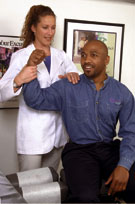Extremities and the Chiropractic Lifestyle
Proper motion is essential for proper function.
When joint function is impaired, there is reduced range of motion, inflammation, calcium buildup, and scar tissue.
This can be caused from repetitive motions, improper sitting, overexertion, slips, falls, accidents, and other causes. Awareness of these types of problems has become more common with terms like “tennis elbow”, “runner's knee”, “frozen shoulder”, and “carpal tunnel syndrome.”
The impaired function of the elbow and other extremity joints of the body can often be helped with proper joint mobilization.
The traditional treatment of these problems can involve splinting the joint to reduce movement, pain medications, muscle relaxers, steroid injections, and even surgery.
What else can be done?
Today, a more common sense approach is being taken. Joint mobilization, like chiropractic care for the spine, is being used in the care of elbows, wrists, and other joints of the body. Helping to restore normal range of motion to joints that have become “locked-up”, “jammed”, or injured, seems to improve blood circulation, reduce scar tissue, and speed the healing process.
Your Doctor of Chiropractic is uniquely trained to detect and help restore proper joint function of the spine and the extremities. Find out if you can be helped, by arranging for a consultation and thorough examination today!
Joint damage from repetitive motion can often be helped with chiropractic care, avoiding braces, drugs, or surgery.
The active lifestyle most retiree’s look forward to depends upon proper mobility of the spine and extremities.
 Finding the cause of your problem.
Finding the cause of your problem.Joints of the body can lose their normal motion and position leading to symptoms of pain, swelling and loss of function.
Many people are surprised to learn that joint pain in the hand, wrist, elbow, shoulder, ankle, or knee can often be helped by chiropractic care.
A detailed history and thorough examination will be performed.
THE CHIROPRACTIC LIFESTYLE
Chiropractors are experts in the care of the bones, nerves, muscles and connective tissues that make up about 60% of your body. All of the joints in your body are part of this musculo-skeletal system and its optimal function is necessary for overall good health. Ask your Doctor of Chiropractic for more information about a care program that may include specific spinal adjustments, exercise recommendations, nutritional advice or other conservative methods of care based on your health history, age, current condition and lifestyle.
REFERENCES:
Hoppenfield, S., M.D., Orthopedic Neurology, J.B. Lippincott Company, 1977.
Calliet, Rene, M.D. Knee Pain and Disability, Pain Series, F.A. Davis, 1983.
Bonebrake, A., D.C. Fernandez, J., D.C., A Treatment for Carpal Tunnel Syndrome: Results of a Follow-up Study, Journal of Manipulative and Physiological Therapeutics, 16:125-139, 1993.
Guch, R., The Chiropractic Theories: A Synopsis of the Research, 2nd edition, Williams and Wilkins, 1986.
Cyriax, J., M.D., Orthopedic Medicine, Diagnosis of Soft Tissue Lesions, Baillere Tindell, Vol. 1. 1984.
Kellett, J., Acute Soft Tissue Injuries: A Review of the Literature, Science in Sports and Exercise, American College of Sports Medicine, Vol. 18, No. 5, pp. 489-500, 1986.
Kessler, R., Hertling, D., Management of Common Musculoskeletal Disorders, Harper and Row, 1983.
Schafer, D.C., Faye, D.C., Motion Palpation and Chiropractic Technique, 2nd edition, Motion Palpation Institute, 1990.
Schafer, R.C., Chiropractic Management of Sports and Recreational Injuries, 2nd edition, Williams and Wilkins, 1986.
Meal, G. M., Scott, R.A., Analysis of Joint Grade by Simultaneous Recording of Sound and Tension, Journal of Manipulative and Physiological Therapeutics, 9:189, 1986.
©2002 Back Talk Systems, Inc.
(800) 937-3113 (303) 277-9990
www.backtalksystems.com
(800) 937-3113 (303) 277-9990
www.backtalksystems.com

